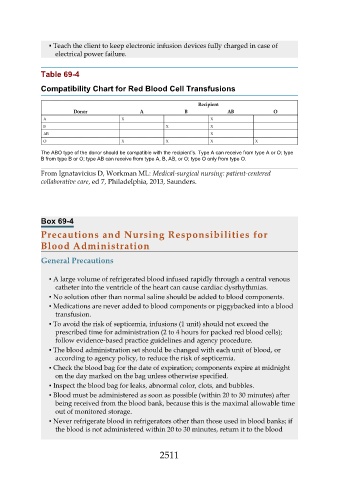Page 2511 - Saunders Comprehensive Review For NCLEX-RN
P. 2511
▪ Teach the client to keep electronic infusion devices fully charged in case of
electrical power failure.
Table 69-4
Compatibility Chart for Red Blood Cell Transfusions
The ABO type of the donor should be compatible with the recipient’s. Type A can receive from type A or O; type
B from type B or O; type AB can receive from type A, B, AB, or O; type O only from type O.
From Ignatavicius D, Workman ML: Medical-surgical nursing: patient-centered
collaborative care, ed 7, Philadelphia, 2013, Saunders.
Box 69-4
Precautions and Nursing Responsibilities for
Blood Administration
General Precautions
▪ A large volume of refrigerated blood infused rapidly through a central venous
catheter into the ventricle of the heart can cause cardiac dysrhythmias.
▪ No solution other than normal saline should be added to blood components.
▪ Medications are never added to blood components or piggybacked into a blood
transfusion.
▪ To avoid the risk of septicemia, infusions (1 unit) should not exceed the
prescribed time for administration (2 to 4 hours for packed red blood cells);
follow evidence-based practice guidelines and agency procedure.
▪ The blood administration set should be changed with each unit of blood, or
according to agency policy, to reduce the risk of septicemia.
▪ Check the blood bag for the date of expiration; components expire at midnight
on the day marked on the bag unless otherwise specified.
▪ Inspect the blood bag for leaks, abnormal color, clots, and bubbles.
▪ Blood must be administered as soon as possible (within 20 to 30 minutes) after
being received from the blood bank, because this is the maximal allowable time
out of monitored storage.
▪ Never refrigerate blood in refrigerators other than those used in blood banks; if
the blood is not administered within 20 to 30 minutes, return it to the blood
2511

